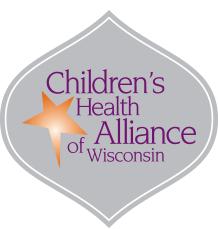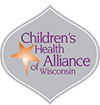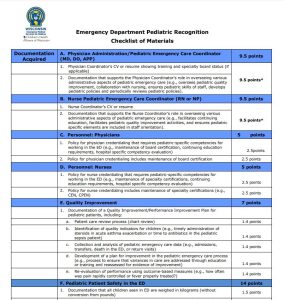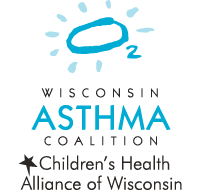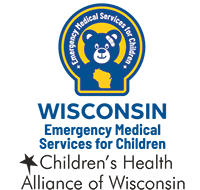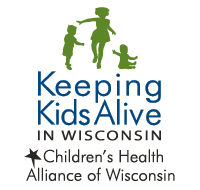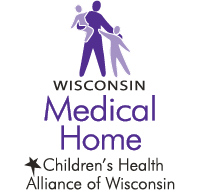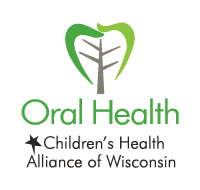Emergency Department Readiness
Emergency Department Readiness
Most sick and injured children seek initial emergency care at the community emergency department (ED) in closest proximity to where they live. It is critical that all EDs have the appropriate resources, capacity, and trained staff to provide effective emergency care for children. Is your department pediatric ready?
The National Pediatric Readiness Assessment (NPRP) is a tool your ED can use to measure your level of pediatric readiness and to aid in identifying gaps that may exist in your preparation to provide pediatric emergency care. The assessment addresses essential domains of preparedness identified by the 2018 American Academy of Pediatrics Policy Statement – Pediatric Readiness in the Emergency Department. These domains include:
- Administration and Coordination of Care of Children
- Physicians, Nurses and Other ED Staff
- Quality Improvement
- Pediatric Patient Safety in the ED
- Policies and Procedures
- Equipment and Supplies Management
ED Pediatric Emergency Care Coordinators (PECCs)
PECCs are ED team members who ensure the pediatric perspective is included in their EDs. PECCs communicate with EMS agencies and coordinate pediatric quality improvement and education. Wisconsin EMSC is committed to increasing the number of PECCs in the state.
Pediatric Readiness: Quality Care, Closer to Home
The Wisconsin Pediatric Readiness Program for Community Emergency Departments (Pediatric Readiness Program) is a program created by Wisconsin Emergency Medical Services for Children (WI EMSC) to help Wisconsin’s community EDs be more prepared to treat children. The goal of the Pediatric Readiness Program is to provide greater access to quality, evidence-based, pediatric treatment, to the EDs that serve Wisconsin’s children. With nearly half of Wisconsin’s children living more than an hour away from specialized pediatric EDs, ensuring that all EDs statewide are able to provide children with the best care possible is critical. The Pediatric Readiness Program helps Wisconsin’s children receive better pediatric care closer to home, improving health outcomes for children statewide. This program is funded entirely by the Advancing a Healthier Wisconsin Endowment.
Cohort 1 EDs
- Aspirus – Rhinelander (St. Mary’s)
- Aurora – Oshkosh
- Aurora – Summit
- Froedtert – Menomonee Falls
- Froedtert – West Bend
- Grant Regional Health Center
- HSHS – St. Vincent Hospital
- Prairie Ridge Health
- River Falls Area Hospital
- SSM Health Ripon Community Hospital
- St. Croix Regional Medical Center
- Tomah Health
Participating Cohort 2 EDs
- Aspirus Langlade Hospital
- Aspirus Wausau Hospital
- Aurora – BayCare
- Bellin Memorial Hospital – Green Bay
- Beloit Memorial Hospital
- Fort HealthCare
- Gundersen Tri-County Hospital
- Indianhead Medical Center
- Tamarack Health Ashland Medical Center
- Mercyhealth – Janesville
- ProHealth Waukesha Memorial Hospital
- Upland Hills Health
- Western Wisconsin Health
Pediatric Weight Conversion Charts
Accurate medication dosing is vital when treating pediatric patients. The American Academy of Pediatrics advises medical providers to weigh pediatric patients in kilograms only to reduce medication dosing errors. Wisconsin EMSC offers paper pediatric weight conversion charts at no cost. Your emergency department can use the charts in a variety of ways.
- Record patient weight in kilograms before entering into an electronic medical records system.
- Give parents a copy of the chart with their child’s weight in kilograms.
- Use the included ring to secure the chart to a scale for weighing pediatric patients.
Please complete the online form to order your free pediatric weight conversion charts today!
Emergency Department Pediatric Readiness Resources
COVID-19 and the ED Digital Toolkit
Social media posts and newsletter templates for your ED’s social media accounts.
Guidelines for Care of Children in the Emergency Department Checklist
Use this checklist to determine if your emergency department is prepared to care for children.
Hospital Recognition Fact Sheet
Learn how pediatric hospital recognition programs designate and verify a hospital’s capacity to provide care to children.
Interfacility Transfer Toolbox
Formalize procedures for transferring pediatric patients to specialized centers for optimal care.
Joint Policy Statement: Guidelines for Care of Children in the Emergency Department
These AAP joint statements outline resources necessary to ensure that EDs are ready to care for children of all ages.
MIS-C Clinical Pathway
Learn about the MIS-C Clinical Pathway specific for Wisconsin.
National Pediatric Readiness Project
Learn about this national, multi-phase quality improvement initiative.
National Pediatric Readiness Toolkit
This toolkit will help you better understand and achieve aspects of pediatric readiness in the emergency department.
Patient- and Family-Centered Care Toolbox
Use these resources to ensure that patient and family perspectives, choices, knowledge, values, beliefs and cultural backgrounds are incorporated into the planning and delivery of care.
Pediatric Disaster Preparedness Toolbox
In a disaster, it’s important to have appropriate pediatric equipment and supplies, medical oversight, protocols and guidelines, and training in the care of children.
Pediatric Equipment Toolbox
This toolbox provides the most recent guidelines, resources, position papers and journal articles on pediatric equipment guidelines.
Pediatric Pain Management Toolbox
The assessment and management of pediatric pain can be a real challenge for health care providers. Learn how to better understand, assess and relieve children’s pain in prehospital settings.
State Pediatric Imaging Guidelines
Use these guidelines when conducting imaging of pediatric patients for blunt trauma.
Pediatric Comfort Kits
Emergency situations can be scary for kids. The Pediatric Comfort Kit contains items to soothe, comfort and distract kids during an emergency. Every emergency response team and emergency department should have a pediatric comfort kit on hand to help kids feel less scared during difficult situations. Request your free Pediatric Comfort Kit today!
Emergency Department Pediatric Recognition
Wisconsin EMS for Children (WI EMSC) has designed the Emergency Department Pediatric Recognition program to identify Wisconsin emergency departments (EDs) that meet the guidelines in the American Academy of Pediatrics’ Policy Statement, Pediatric Readiness in the Emergency Department. In order to receive Emergency Department Pediatric Recognition, an ED needs to meet the following requirements:
- Administrator support letter
- Disaster plan which addresses pediatric patients, and includes the seven components identified in the Pediatric Readiness Assessment
- Minimum score of 80 out of 100 on the Pediatric Readiness Assessment
- Nurse Pediatric Emergency Care Coordinator
- Physician Pediatric Emergency Care Coordinator
- Record pediatric patients’ weights in kilograms only
- Weigh pediatric patients in kilograms only
- Written pediatric interfacility transfer guidelines, which include the eight components identified in the Pediatric Readiness Assessment
- Written pediatric interfacility transfer agreements
Contact Our Staff
Carissa Brunner, MPH, CLC
Program Leader
Emergency Care
(414) 266-4773
cbrunner@childrenswi.org
Sign Up for Our Newsletter
1-2-3 EMSC
A quarterly newsletter highlighting pediatric emergency care news and events.
Emergency Medical Services for Children is funded by the Wisconsin Department of Health Services, Division of Public Health, through the National Emergency Medical Services for Children program, administered by the Health Resources and Services Administration’s Maternal and Child Health Bureau.
